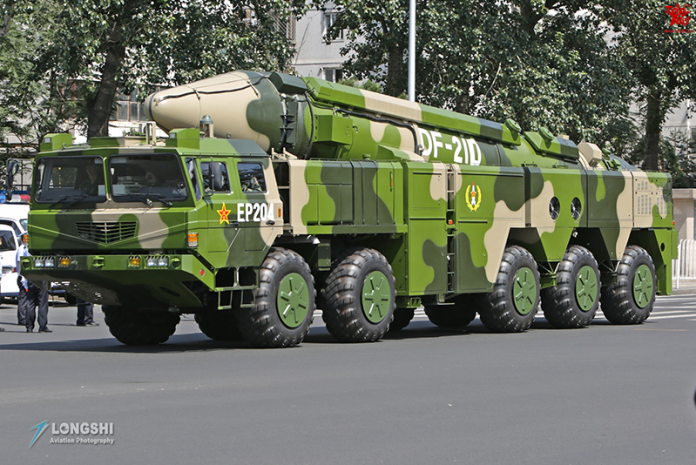The People’s Liberation Army (PLA) tested its much-vaulted anti-ship ballistic missile (ASBM) capability at sea last month, according to news outlets CNBC and NHK, quoting American defence sources.
A Pentagon official said that a total of six missiles were fired from the mainland into the South China Sea (SCS) over a few days, marking the first deployment of such a capability at sea. However, other details of the test, like what type of missile was used, remain scant.
Marking a significant escalation in China’s military posture in the hotly disputed SCS, the ASBM drill came on the back of rising politico-military tensions in the Asia-Pacific region and was arguably carried out to send a strong message to Beijing’s strategic rivals in the region, especially the United States.
The ‘China threat’ thesis has gained increasing prominence in American policy-making circles in recent years. Indeed, the 2018 National Defense Strategy (NDS) released early last year alludes to “inter-state strategic competition… as the primary concern in US national security” and explicitly names China as inimical to US interests. In the months since the document’s release, there has been much debate over how best to implement the NDS. To illustrate, Washington DC think-tanks have come up with new operational concepts to counter China.
This period has also seen increasing American and allied naval deployments by the likes of Britain, Canada, and France to the region. For instance, the French carrier Charles De Gaulle and its consorts recently completed a four-month deployment in the Indo-Pacific. In addition, the United States’ Ronald Reagan carrier strike group conducted drills in the South China Sea with the Japanese helicopter destroyer Izumo in mid-June. What is more, these developments overlapped with the Sino-American trade imbroglio.
Naturally China felt somewhat reined in by these events and saw the need to respond forcefully. A par for the course deployment of regular forces (again) such as anti-ship cruise missiles or fighter jets would arguably not send a strong enough message of deterrence. It was time for a step-change. And what better way for China to do this by showcasing one of its silver bullets? After all, the PLA’s two anti-ship ballistic missile types far exceed in terms of striking reach everything else in its conventional missile inventory.
The DF-21D ‘Carrier Killer’ can hit targets around 1,500 kilometres away, holding at risk enemy ships within and around the First Island Chain. The DF-26 ‘Guam Express’, as its nickname suggests, is even more potent as it can hit the American territory given its stated range of some 4,000km. The ASBM was developed primarily to counter the threat of US carrier forces, and July’s test of this capability were arguably meant to signal to Beijing’s potential foes that it was serious about defending its regional interests, whether they be in the two China seas or over Taiwan.
Going forward, July’s ASBM drills could just be a one-off event. However, some commentators speculate that China’s ASBM drills in July could be the harbinger of stepped-up Chinese belligerency. Therefore, expect more of such developments with different, more potent capabilities. That being said, what would really raise eyebrows and cast a cold chill over the region is the successful testing of the Chinese ASBM against a mobile maritime target. After all, this capability has been tested only against stationary objects on land, which does not offer the complexity of a maritime target. Alarm bells would ring even harder in Western defence establishments should such a successful test also involve other capabilities such as missiles launched from other platforms like aircraft and submarines.
Should this come to pass, the US Navy will have to genuinely face up to a threat which bedevilled its planners during much of the Cold War – the multi-domain, multi-vector attack launched by the Soviets to overwhelm an American carrier force. The 21st Century Chinese incarnation could be ominous given the strides made in ship-killing technology using the ASBM.
by Ben Ho













